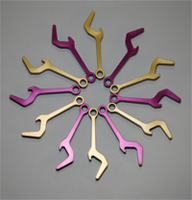Aluminum Extrusions

The process
Extruded aluminum is perhaps the most versatile and cost effective metalworking process available to designers and engineers. The aluminum extrusion process has been compared to the play dough toy you had as a kid that would make the girders and tubes. Simply put, extruding involves pushing material through an opening in a die. Producing an aluminum extrusion is a little more complex. Let’s start with the press, which serves as the hydraulic ram to force the aluminum billet through the die. Some can generate force exceeding 5000 tons. Today’s modern presses are fully instrumented to produce the optimal pressure and temperature for each particular shape. The material flows through the die and on to a run out table. At this point the profile may be stretch straightened in order to eliminate twist. In most cases the extrusions are then moved on to heat treat where they are artificially aged to a specific temper.
The extrusion die is what determines the profile. There are three basic classes or types of extrusion dies, solid, semi hollow and hollow dies. Hollow dies are the most complex and therefore expensive. In hollow dies the metal flows around mandrels and literally welds itself together on the other side of the mandrel.
Common industrial applications for aluminum extrusions include aircraft components, rails, tracks, enclosures and heatsinks. Thermal management applications are some of the most challenging for the aluminum extruder as the drive for efficiency demands thinner sections and higher fin ratios.
Design considerations
Standard Tolerance
- Profile/Cross Section +/- .008 per measured inch
- Straightness .0125” for every foot of length
- Twist 0.5 degree for every foot of length
- Flatness .004” per inch of width
- Wall thickness +/- 10%
The tolerances listed above are a rule of thumb and are quite generous for the extruder. Custom extrusions can be held to much tighter tolerance. Send us a print or file and let us see what we can do.
Economic/Purchasing Considerations
Although relatively inexpensive, extrusion dies are made for a specific press and are of no use to a different extruder. There has been a lot of shakeup in the extrusion industry as of late. Make sure you are dealing with a financially stable company.
Two factors determine the price of aluminum extrusions, the billet (aluminum) cost and the conversion factor. The conversion factor is estimated based upon how fast the extruder feels that the material will go through his press. Intricate, thin walled shapes require the press to extrude the material slower, resulting in a higher conversion factor.
How we can help
We have access to literally hundreds of standard shapes as well as a number of aircraft open dies. Our specialty however is to provide you with a complete part, extruded, fabricated, machined, finished and ready for assembly. We can provide extrusions up to a 12 inch circle size in 6000 series aluminum. We also work with 2024 as well as 7075 aluminum in smaller shapes.
